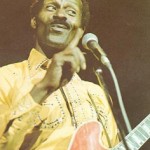BIOGRAPHY
CLICK TO READ ON:
> GUITAR LESSONS
> SOME GOOD ADVICE
> THE REST IS HISTORY
QUOTES
FILMS
DATE |
TITLE |
| 1995 | History of Rock 'n' Roll - Rock 'n' Roll Explodes |
| 1993 | History of Rock 'n' Roll - Guitar Heroes |
| 1993 | Bluesland: A Portrait in American Music |
| 1987 | Chuck Berry: Hail Hail Rock 'n' Roll |
| 1985 | Chuck Berry & Bo Diddley's Rock 'n' Roll All-Star Jam |
| 1982 | National Lampoon's Class Reunion |
| 1978 | American Hot Wax |
| 1973 | London Rock and Roll Show of 1973 |
| 1973 | Let the Good Times Roll |
| 1969 | Little Richard: Keep on Rockin' |
| 1969 | Chuck Berry: Rock 'n' Roll Music |
| 1965 | Chuck Berry Hosts: BORN TO ROCK - The T.A.M.I. - T.N.T. Show |
| 1959 | Jazz on a Summer's Day |
| 1959 | Go Johnny Go (PAL only) |
| 1957 | Mister Rock and Roll |
| 1956 | Rock, Rock, Rock |
| NA | Chuck Berry: Live at the Roxy with Tina Turner |
| NA | Joined on Stage By Tina Turner |
CAREER HIGHLIGHTS
June 9th, 2017 The long awaited final studio album CHUCK, is released to critical acclaim.
August 26, 2014 Chuck honored with the prestigious Polar Music Prize.
December 2, 2000 Honoree at the 23rd Kennedy Center Honors.
September 2, 1995 Performs "Johnny B. Goode" alongside Bruce Springsteen at the Concert for the Rock and Roll Hall of Fame in Cleveland.
October 8, 1987 The film " Hail! Hail! Rock and Roll" is released. It is a live tribute to Berry, and is directed by Keith Richards of the Rolling Stones.
1987 Publishes his honest and insightful autobiography.
January 23, 1986 Inducted into the Rock and Roll Hall of Fame in New York City.
February 26, 1985 Receives Lifetime Achievement Award at the 27th Annual Grammy Awards.
June 1, 1979 Performs for President Jimmy Carter.
March 1, 1978 Appears as himself in the film "American Hot Wax," a biography about deejay Alan Freed.
October 21, 1972 The song "My Ding-a-Ling" (originally "My Tambourine") reaches No. 1, the only Berry recording to top the charts.
May 1, 1972 The London Chuck Berry Sessions is released; it becomes Berry's top-selling album, hitting No. 8 on the charts.
1965 Appears in concert film featuring the TAMI (Teen-Age Music International) Show, along with The Beach Boys, Rolling Stones and more.
May 31, 1961 Opens own amusement park, called Berryland, outside St. Louis.
March 17, 1958 "Sweet Little Sixteen" grabs No. 1 spot on R&B chart and No. 2 on pop chart, while rock & roll classic"Johnny B. Goode" gets No. 2 on R&B and No. 8 on pop.
September-November 1957 Goes on tour with the "Biggest Show of Stars for '57," which also included Buddy Holly, the Everly Brothers, etc.
June 30, 1956 Berry's song "Roll Over Beethoven" takes the second spot on the R&B chart, and gets to No. 29 on the pop chart.
September 1955 "Maybellene" hits No. 5 on Billboard's Rock and Roll Singles chart.
May 21, 1955 Records first songs, "Maybellene" and "Wee Wee Hours."
May 1955 Takes a roadtrip to Chicago; talks briefly to Muddy Waters, who refers him to Chess Records. There he lands a recording contract.
December 30, 1952 Receives a call from pianist Johnnie Johnson asking Berry to join the Sir John's Trio, a band that played at the very popular Cosmopolitan Club.
June 13, 1952 Joins Tommy Stevens in a house band that played Huff's Garden every Saturday.
1941 Performs at his school's musical stage performance, singing "Confessin' The Blues" while accompanied by his friend, Tommy Stevens, on guitar. Stevens' powerful performance inspires him to learn how to play the instrument himself.
AWARDS
2014 Polar Music Prize
2012 PEN Literary Award Winner
2002 BMI ICON award winner; other winners were Little Richard and Bo Diddley
1987 Receives a star on Hollywood Boulevard in California
1989 Honored with a star on Delmar Boulevard in St. Louis, Missouri
1985 Inducted into the Rock and Roll Hall of Fame
1985 Receives Lifetime Achievement Award at the 27th Annual Grammy Awards
1982 Inducted into the Nashville Songwriters Association International Hall of Fame
ACHIEVEMENTS
First singer/songwriter of 1955
First guitarist/singer to get on Billboard charts
Directly inspired great rock icons The Beatles, Beach Boys, Rolling Stones and Elvis Presley
United blacks and whites by producing music that appealed to everyone
His single "Johnny B. Goode" made the top 10 in 1958
Had the number one single in 1972 with "My Ding-a-ling"
Performed for President Jimmy Carter at the White House in 1975
Was inducted into the Rock and Roll Hall of Fame in 1986
Released his autobiography in 1987
"Hail! Hail! Rock 'n' Roll" made its debut in 1987
Berry performed "Johnny B. Goode" with Bruce Springsteen at the Concert for the Rock and Roll Hall of Fame in 1995
1977 Johnny Be Goode included content on Voyager 1 spacecraft
FAST FACTS
GENERAL INFORMATION
Birth Name: Charles Edward Anderson Berry
Nicknames: Father of Rock ‘N’ Roll, The Prime Minister of Rock ‘N’ Roll
Occupation: Musician
Born: October 18, 1926
Birth place: St. Louis, Mo.
Parents: Henry and Martha Berry
Wife: Themetta Suggs-Berry
Children: Darlin Ingrid Berry-Clay, Melody Exes Berry-Eskridge, Aloha Isa Lei Berry, Charles Edward Berry Jr.
Siblings: Henry, Thelma, Lucy, Paul, Martha
Weight: 180 lbs
Musically influenced by: Nat "King" Cole, Muddy Waters
Trademark: Duckwalk
FAVORITES
Food: Enjoyed beef and seafood, peaches, home fries, candied yams, chili, grape soda, orange juice, Snickers bars and Dutch apple pie. Despised liver, okra, gumbo, celery, carrots, cooked onions, grapefruit, salami and liquor.
Hobbies: Playing music, softball, twenty questions, chess, croquet, highway driving
Comedians: Lucille Ball













